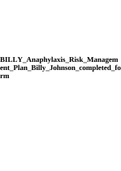Samenvatting
Korte Samenvatting / Short Summary Introduction into Criminology for Social Science Students (RGBUSTR007)
- Vak
- Instelling
- Boek
Dit document bevat een samenvatting van de informatie van de hoorcolleges (1 t/m 6) het vak Criminology for Social Science Students. De aantekeningen zijn volledig in het Engels en bieden een grondige uitleg van verschillende theorieën, perspectieven en begrippen die in het vak behandeld worden. E...
[Meer zien]









